First test on the new Ducati Sportbike
Alan Cathcart gets one of 12 invites to test the delectable 2019 Ducati V4 R. This is one serious, serious machine.
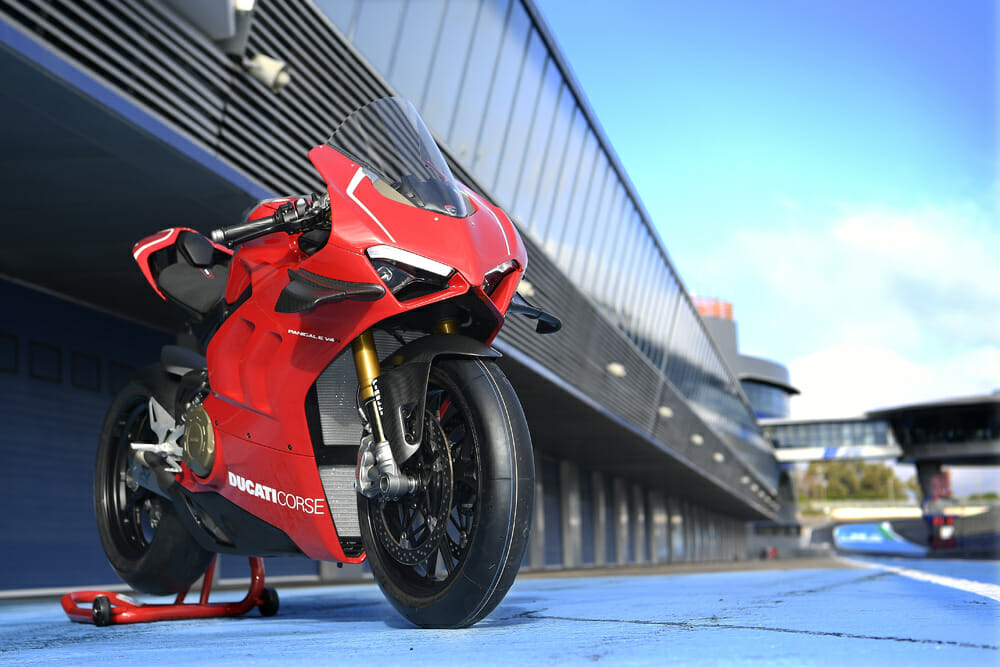
The year 2019 represents a watershed moment for Ducati and, indeed, for Superbike racing in general.
That’s because for the first time ever in the past 31 years since the WorldSBK Championship began in 1988, there’ll be no Desmo V-twin Ducati on the grid when the series kicks off at Phillip Island in February.
Indeed, for the first time ever, there will be no twin-cylinder motorcycles of any kind—all the bikes on the grid will have 1000cc four-cylinder engines for the first time since 2008, when the FIM lifted the capacity ceiling for twins to 1200cc, against 1000cc fours.
Ducati has finally ended its line of Desmo V-twin racers stretching back to 1972, when Paul Smart won the Imola 200, which was the Italian manufacturer’s debut race with a 750cc Desmo V-twin. Fourteen WorldSBK titles later—the last of them won as long ago as 2011 by Carlos Checa with a 1098R—Ducati has now finally produced a four-cylinder model for Superbike racing. This is closely based on its Desmosedici V4 MotoGP contender originally introduced back in 2002, with the latest version of which Andrea Dovizioso has been runner-up in the past two MotoGP World Championships to the Marc Márquez/Honda duo.
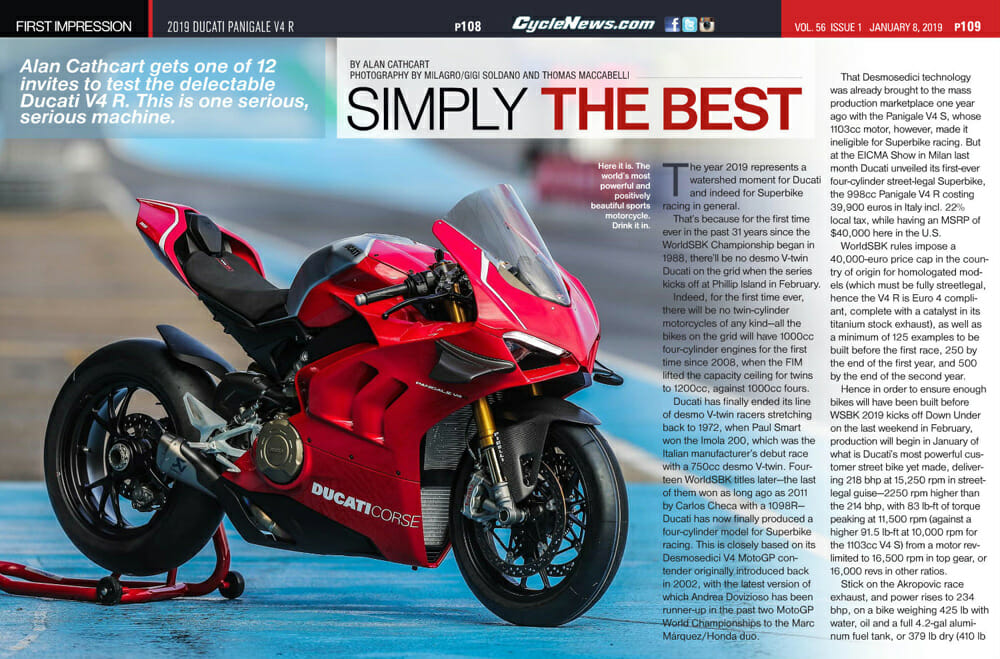
Photography by Milagro/Gigi Soldano and Thomas Maccabelli
Click here to read this in the Cycle News Digital Edition Magazine.
That Desmosedici technology was already brought to the mass-production marketplace one year ago with the Panigale V4 S, whose 1103cc motor however made it ineligible for Superbike racing. But at the EICMA Show in Milan last month, Ducati unveiled its first-ever four-cylinder street-legal Superbike, the 998cc Panigale V4 R costing euro 39,900 in Italy incl. 22% local tax, while having an MSRP of $40,000 here in the U.S.
WorldSBK rules impose a euro 40,000 price cap in the country of origin for homologated models (which must be fully street legal, hence the V4 R is Euro 4 compliant, complete with a catalyst in its titanium stock exhaust), as well as a minimum of 125 examples to be built before the first race, 250 by the end of the first year, and 500 by the end of the second year.
Hence, in order to ensure enough bikes will have been built before WSBK 2019 kicks off Down Under on the last weekend in February, production will begin in January of what is Ducati’s most powerful customer street bike yet made, delivering 218 bhp at 15,250 rpm in street-legal guise—2250 rpm higher than the 214 bhp, with 83 lb-ft of torque peaking at 11,500 rpm (against a higher 91.5 lb-ft at 10,000 rpm for the 1103cc V4 S) from a motor rev-limited to 16,500 rpm in top gear, or 16,000 revs in other ratios.
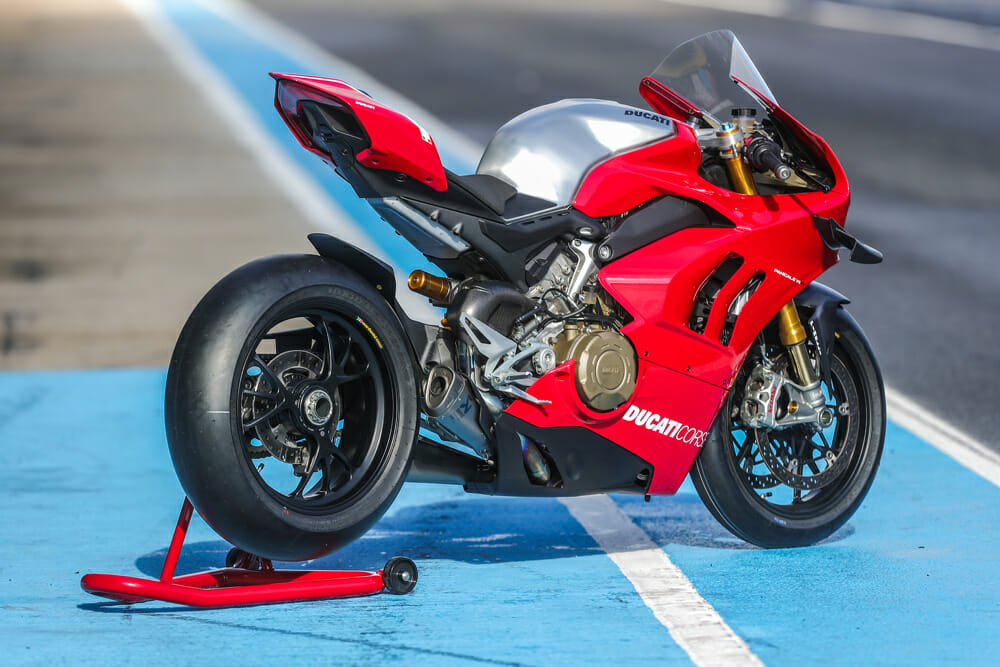
Stick on the Akrapovič race exhaust, and power rises to 234 bhp, on a bike weighing 425 pounds with water, oil and a full 4.2-gallon aluminum fuel tank, or 379-pound dry (410-pounds ready to race, minus lights, etc., but with fuel).
But Ducati doesn’t regard the V4 R as a limited-edition special, like the 500 off Superleggera, which sold out immediately in 2017, despite at Euro 80,000 costing exactly double the price of the V4 R, with half the number of cylinders.
“We anticipate building at least 1000 examples of the V4 R in 2019,” says Ducati’s Product Manager, Paolo Quattrino. “While of course it’s a very expensive model, we believe that the high level of technology and the outstanding performance will attract many customers—not only committed Ducatisti, but we hope to conquest customers from other brands. So, this will not be a limited-edition model.”
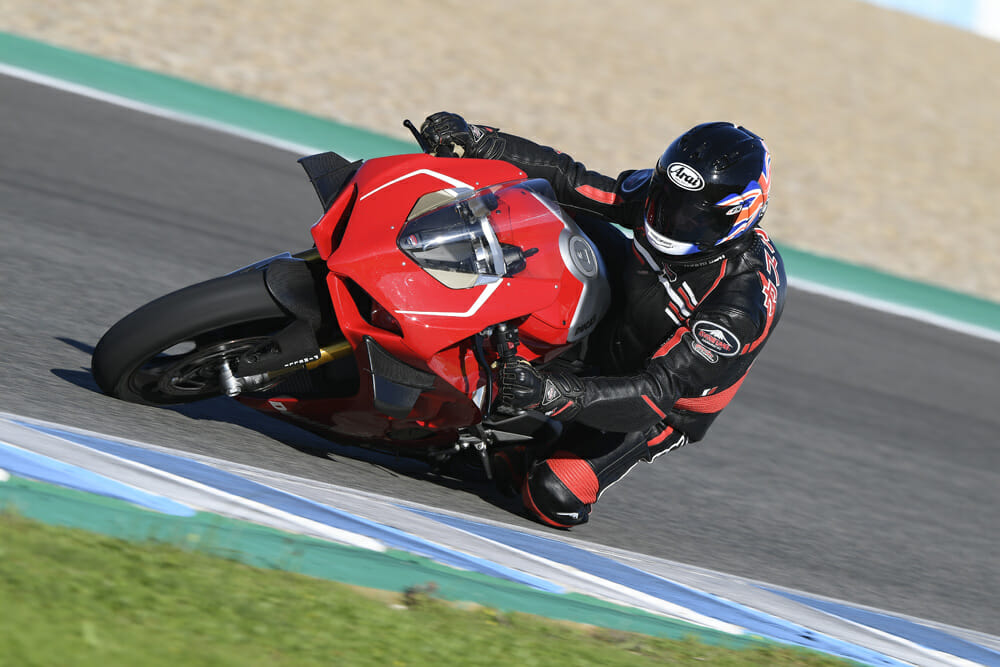
Test Riding the 2019 Ducati V4 R at Jerez
Just three weeks after its EICMA debut, Ducati allowed a few privileged journalists—just one dozen of us from all over the world—to join factory WorldSBK riders Chaz Davies and Alvaro Bautista for a day aboard the bike at the Jerez circuit in the sunny south of Spain.
Well, that was the idea, anyway, but the day did not start well, with rain, mist and a wet track. But soon after midday, the track dried up, and that afternoon I spent 35 laps aboard the V4 R, gradually becoming more and more impressed by it. This is quite some motorcycle.
For while it shares the same technical basis as the more prosaic but still super-performing V4 S, this is a very different motorcycle to ride. Firstly, of course, because of the engine, which thanks to its shorter-stroke format measuring 81 x 48.4mm—as opposed to 81 x 53.5mm for the S-model, remembering that an 81mm cylinder bore is the largest diameter allowed for Superbike racing—already has a greater appetite for revs, even before the V4 R’s adoption of a 2.4-pound lighter backwards-rotating forged steel crankshaft, plus titanium conrods and 34mm intake valves (with 27.5mm steel exhaust valves).
This not only lifts the rev ceiling to that amazing 16,500-rpm limit, but also allows the V4 R to pick up revs harder and faster exiting a turn. It’s aided in that by the same Twin Pulse firing order as on the D16 MotoGP bike, obtained via a 70-degree crankpin offset together with a 90-degree V4 cylinder angle, with the two left cylinders essentially firing closely together, followed by the two right ones in a 0°, 90°, 290° and 380° firing order.
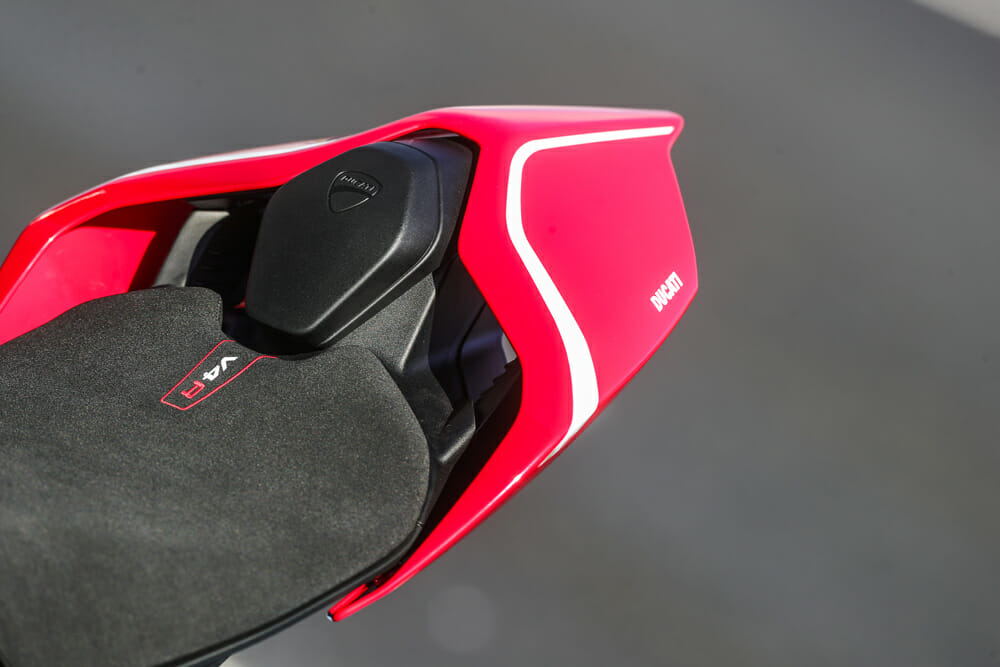
This makes the V4 R sound just like the MotoGP Desmosedici V4, complete with the same chilling high-pitched hollow-sounding roar from the dual exhausts, which you’re very well aware of when riding the bike, as well as when standing trackside.
Yet despite breathing through a quartet of huge elliptical throttle bodies (equal to 56mm in diameter), the Desmo V4 R motor is highly tractable, even friendly, in the way it makes power. You could honestly imagine riding this bike to the shops, it pulls so cleanly from low down, barely off the 1500 rpm idle speed, with zero transmission snatch and only a little use of the relatively light action dry slipper clutch. Yes, for the first time in many years, the trademark Ducati rattle is back of the clutch plates kissing each other at low revs, without the oil bath they’d otherwise be sitting in to quieten them down.
Power builds in a totally linear way, until just above 8500 rpm—when 80 percent of maximum torque is already available, only halfway to the redline—things start to happen a lot faster. That’s when this “small” V4 engine sends you catapulting forward even faster than its big sister does in the V4 S, while still delivering an enormously broad powerband, which means you end up holding second and third gear for long stretches of the Jerez track, where Chaz Davies says he only uses four of the six gears on his racebike.
The race-pattern (one up, five down) powershifter naturally works clutchlessly in both directions, though I had to remember to be quite forceful in selecting bottom gear for the slow Curva Lorenzo final hairpin leading on to the start/finish straight. There, I got a false neutral going from second to first half a dozen times, though maybe this would be less of an issue with more mileage on the gearbox to loosen it up. Either that, or use second gear as Chaz told me he does.
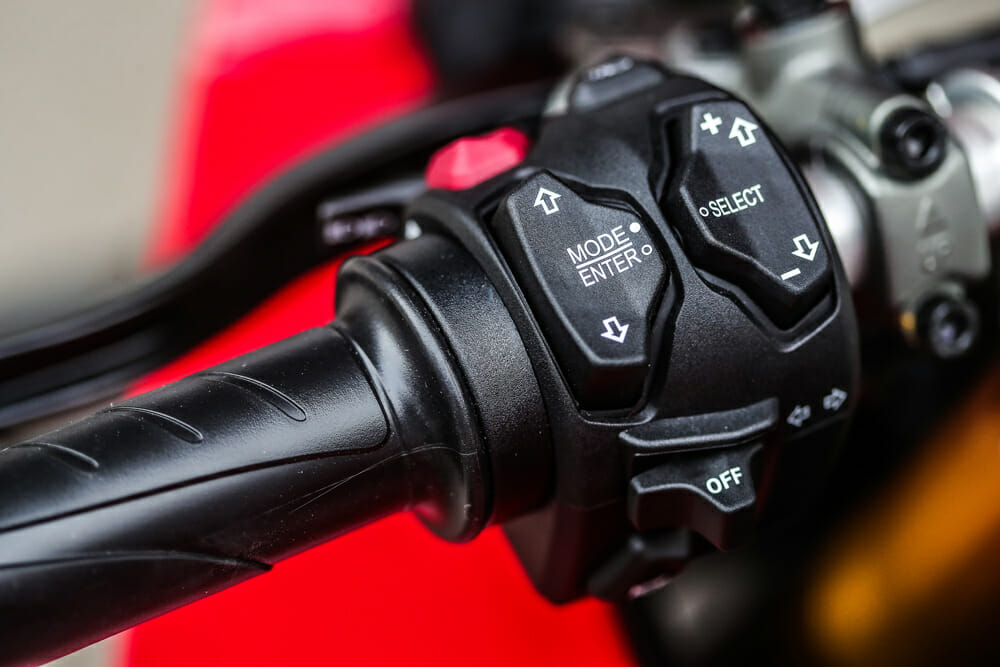
2019 Ducati V4 R Engine
From 13,000 rpm onwards, the variable-length intake funnels lift to shorten the intake paths, so that the higher-lift race-spec camshafts can start to do their work. You honestly don’t feel this transition—and knowing it was there, I did look for it, but there’s no trace of any steps in the power delivery. Instead, there’s just a strong, relentless build of revs and the power they deliver—and this was with the Akrapovič titanium race exhaust system fitted to all four of our test bikes. One presumes the stock Euro 4-compliant street exhaust is even friendlier in its function. What’s more, this was in Race mode out of the choice of three available. Sport and Street are the other two, all delivering full power, but with different degrees of throttle response. And there’s no Rain mode.
The V4 R motor builds speed very fast, pulling irresistibly rather than explosively but with a huge sense of purpose, until an orange shifter light appears across the top left of the same five-inch TFT dash as on the V4 S at 14,500 rpm, then a red one on the right at 15,000.

The high revs are made possible by the absence of valve springs on this Desmodromic engine, allowing the use of more radical camshaft design alongside the lightweight internals and reduced friction from items like the two-ring ultra-slipper forged aluminum pistons delivering the high 14:1 compression ratio, another reason for the V4 R’s super-strong drive out of turns.
There’s no hard cutout when you reach the 16,000 rpm rev-limiter—the RBW digital throttle simply down tools, and stops pulling. Below that, the famed nirvana of a direct connection via the throttle pickup between your right hand and the rear Pirelli slick fitted for our test is very much present. Despite there being so much power and such extremes of performance on tap, this is a super-controllable motorcycle with a well-controlled power delivery, even when ridden in something approaching anger on a race track.
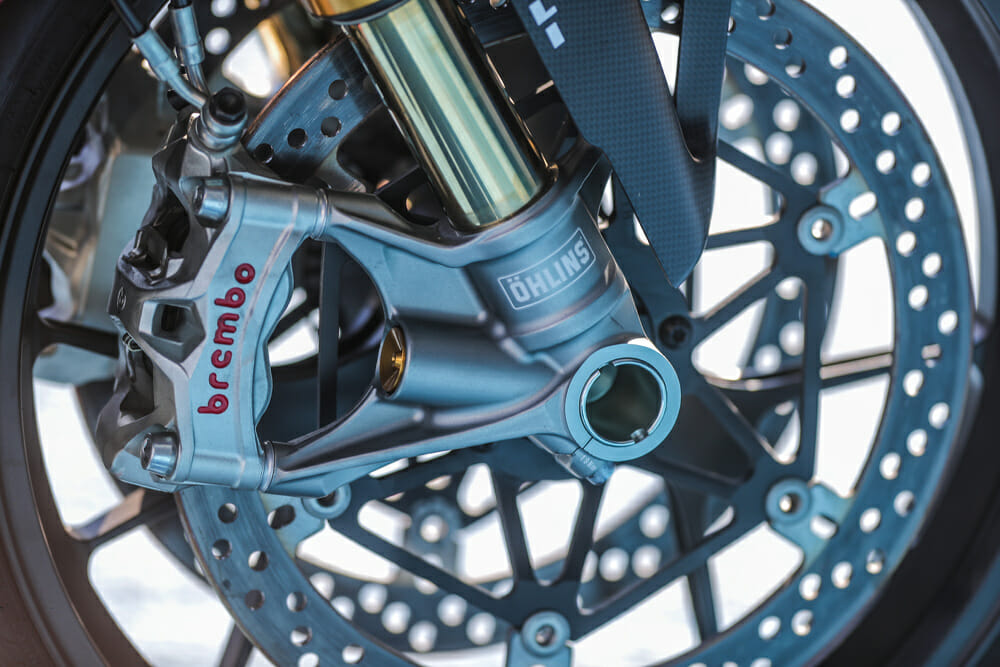
Rider Review of the 2019 Ducati V4 R
Then there’s the handling. Basically, the V4 R’s black-painted cast-aluminum abbreviated twin-spar chassis is the same so-called “Front Frame” design as on the V4 S, but with less metal behind the steering head to deliver a little more flex aka “optimized stiffness” (WorldSBK regs allow the addition of material to the frame, but not the removal of any).
That’s important for Chaz and Alvaro, but less so for the likes of us, so it wasn’t so tragic that the test bikes weren’t yet equipped with this frame configuration that’s yet to be manufactured in volume for production. But the geometry is identical between the two—the only difference is in the degree of flex, and of course a small amount of weight. The single-sided cast-aluminum swingarm delivers a seemingly rangy 57.9-inch wheelbase, despite which the V4 R likes to wheelie under hard acceleration, and there’s now a choice of four positions for the swingarm pivot in 2mm increments.
The Öhlins Smart EC 2.0 suspension found on the V4 S is missing from the V4 R, because electronic suspension is banned from WorldSBK. Instead, the V4 R features a 0.6kg lighter mechanically adjusted TiN-coated 43mm Öhlins NPX 25/30 pressurized gas fork, which combines well with the TTX-36 rear shock to deliver a huge amount of confidence, coupled with a sense of agility that I wasn’t prepared for from the V4 R’s chassis package.
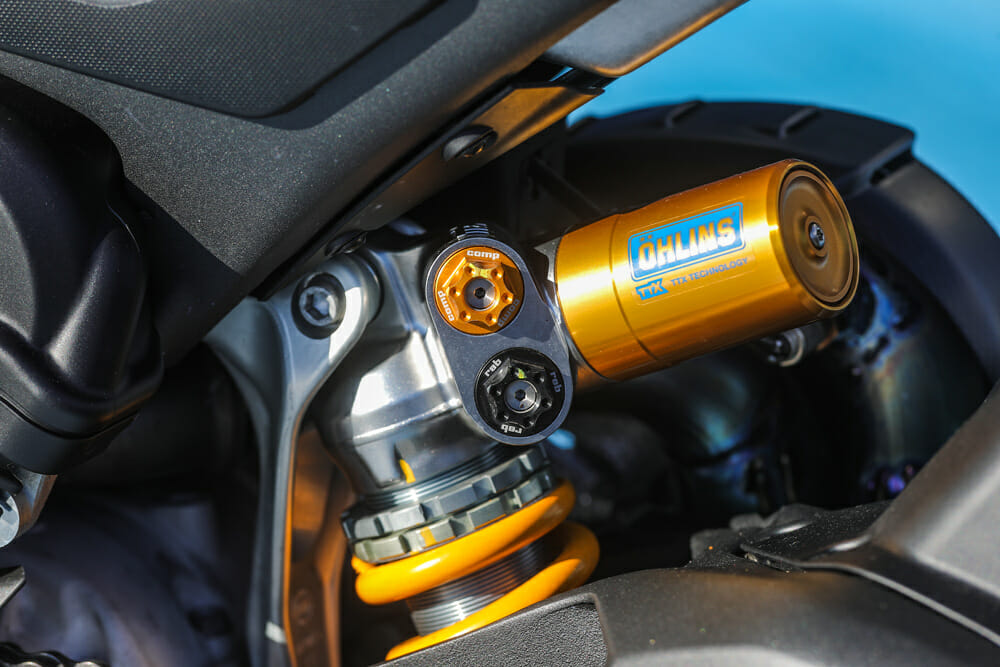
However, having been fortunate enough to test ride every single factory WorldSBK machine year on year between 1988 and 2015, the new Ducati’s practically dainty handling strongly reminded me in the way it steered of the 750cc Castrol Honda RC45 with which John Kocinski won the WorldSBK title in 1997. That earlier Japanese 90° V4 Superbike combined two often mutually exclusive traits, agility and stability—and that’s what the similar-format Ducati V4 R also encompasses, but in a much more powerful package. Despite the long wheelbase, the V4 R was easier to change direction on than any Desmo V-twin Superbike I’ve yet ridden.
The new Ducati hugged a line really well even under hard acceleration, and although without any chicanes (hooray!) Jerez isn’t an ideal circuit to test a bike’s ability to switch from side to side very quickly except at turns two and three, it seemed both agile and quickly responsive to steering input. I suspect the reason it steers so well isn’t so hard to figure out—the compact build of the 90° V4 engine centralizes the mass of the bike, and having that right-angle cylinder layout means that it’s got a lower center of gravity, as well. That’s because there’s room to sink the throttle bodies down between the cylinders in a way that couldn’t be done on Max Biaggi’s and Sylvain Guintoli’s taller, three-time world-champion tighter-angle 65º V4 Aprilia, which the new Ducati however reminds me of in terms of power-delivery characteristics, with that broad spread of torque.
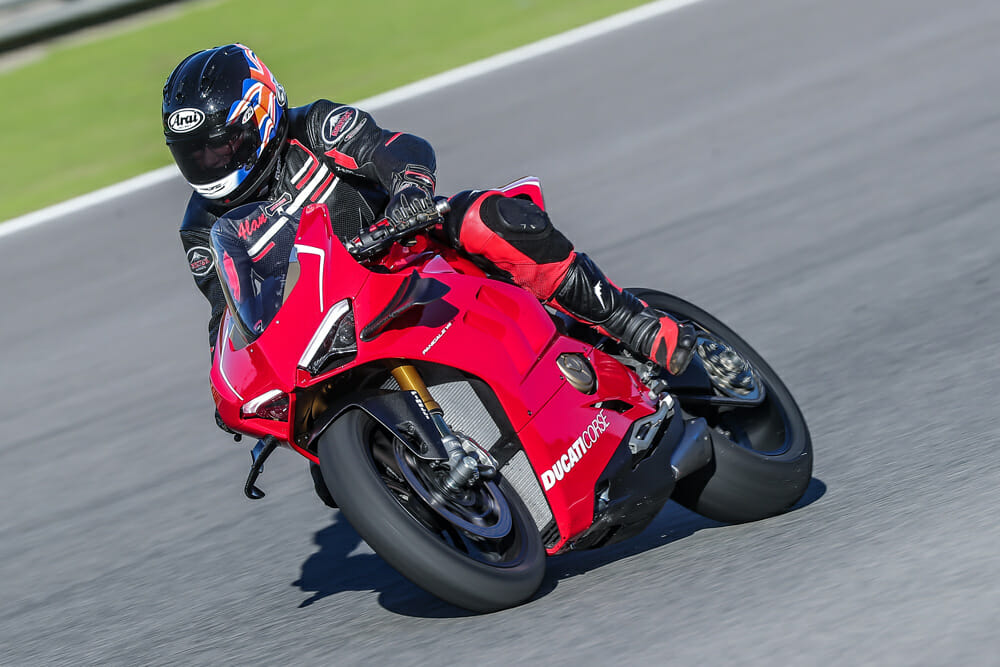
The V4 R’s lower build was surely another reason, besides the super well set-up Öhlins suspension, that it rode the bumps so well on a Jerez circuit closed for complete resurfacing two days after my ride there.
With a slightly softer front and a stiffer spring at the rear than on the V4 S, the R-model’s Öhlins suspension package delivers impressive stability, and outstanding feedback. There’s a huge sense of response from the front, which gives you extra confidence in keeping up turn speed, and thanks also to the 54/46-percent forward weight bias this indeed applies under hard braking, where the large 330mm twin front discs and the lighter, more sculpted, latest-spec four-piston Brembo Stylema one-piece radial calipers, exclusively developed for the V4 R, do a phenomenal job of stopping the bike hard from high speed, but with great sensitivity and no hint of grabbing.
Styling on the Ducati Panigale V4 R – Ducati Gives You Wings

There’s also a nice degree of engine braking still left dialed into the settings for the STM ramp-style slipper clutch. All this means you have heaps of confidence in keeping up turn speed in a corner like the off-camber third-gear sweeping right-hander named after Sito Pons, which leads on to the back straight at Jerez. You can feel via your fingertips how well the front Pirelli is gripping the tarmac—a confidence that may perhaps be derived from the winglets fitted to the bike. These are the first ever featured on a customer Ducati streetbike, and are derived from the 2016 type used by Ducati in MotoGP before the regulations were changed to make them less intrusive visually—albeit apparently less functional.
However, the ones on the V4 R don’t suffer from that handicap, and in delivering greater downforce on the front wheel at high speed—35 pounds at 125 mph, and 66 pounds at 165 mph says Ducati aerodynamics engineer Edoardo Lenoci, all without affecting top speed at all – they undoubtedly play a role in both maximizing front tire grip and rider confidence. When you sit up and brake for a turn, you can just see them peeping out from either side of the new fairing design, even though this is 1.4-inch wider on either side than on the V4 S, and 1.1-inch broader at the front.
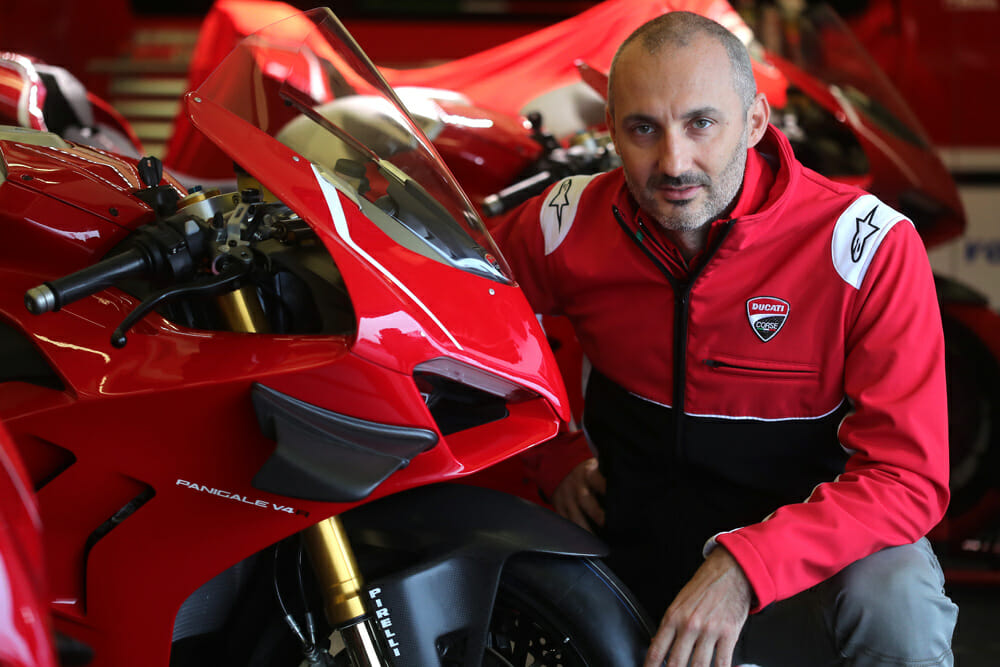
This wind-tunnel developed revised bodywork also features a more tightly domed 1.3-inch taller screen, all together resulting in increased rider protection, though I must admit that at busy, twisty Jerez, the most I spent tucked down behind it was about four seconds per lap! Aragon, or Phillip Island, would be a different matter.
The revamped bodywork also includes large gill-like openings in each flank as a consequence of which the radiators (same as on the V4 S) can dissipate their heat much more efficiently. According to Lenoci, these new vents increase airflow through the water and oil radiators by as much as 6 percent and 16 percent, respectively. Plus, the intake apertures in the nose of the fairing are much larger than on the V4 S, for deeper breathing at higher revs. Form follows function.
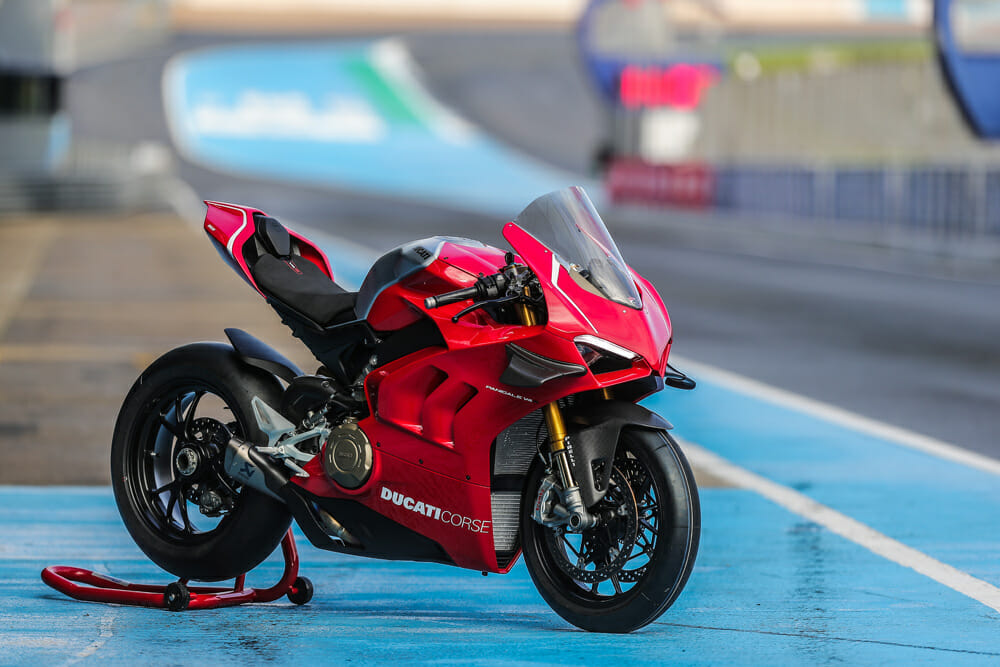
The V4 R’s Bosch electronics package featuring a six-axis IMU offers everything from a lap timer to launch control, including Cornering ABS, pit-lane speed limiter (adjustable from 24/49 mph, so good for avoiding speeding tickets in all those little towns and villages in Italy and elsewhere which see trapping riders for 2 mph over as a useful cash cow), Ducati Wheelie Control (DWC), Ducati Traction Control EVO, Ducati Slide Control, Engine Braking Control, etc. The DWC could have worked better—I had a couple of bigtime power wheelies shifting into third gear from second at just the wrong point in the rev range—but the DTC was particularly effective, repeatedly intervening, gently but effectively, in one session where the rear Pirelli had started to wear after countless journo laps. Ducati has had lots of experience about how to map this properly, and it shows.
It also has a lot of experience in how to build Superbike racers-with-lights. This is the latest one—and, by some way, the best yet. I predict that, despite the high price, Ducati will sell its 1000-plus examples of the V4 R with some ease, in which case, just wait for BMW to produce a comparable M-version of its new S 1000 RR, with a power-up WorldSBK-spec engine package to go with all the carbon-fiber M-parts already on offer. Except, the Ducati V4 R is already here, delivering a unique level of street-legal performance from a series production motorcycle. Start saving now! CN
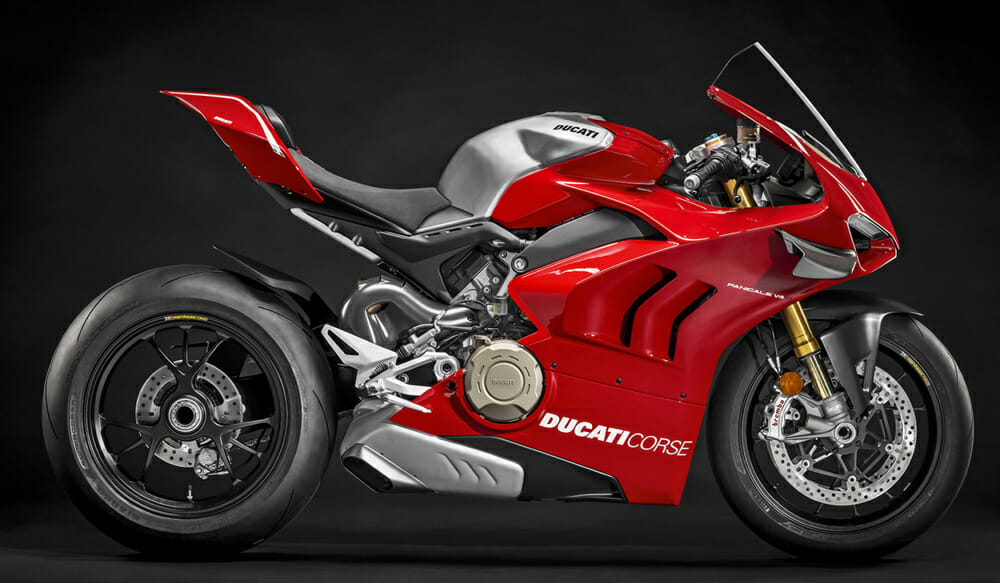
| SPECIFICATIONS | 2019 Ducati Panigale V4 R |
| Engine: | Desmosedici Stradale 90° V4, rearward-rotating crankshaft, 8 Desmodromically-actuated valves |
| Displacement: | 998cc |
| Bore x stroke: | 81 x 48.4mm |
| Compression ratio: | 14:1 |
| Fuel system: | Electronic fuel-injection system. Twin injectors per cylinder. Full ride-by-wire elliptical throttle bodies with aerodynamic valves. Variable-length intake system |
| Power: | 218 bhp at 15,250 rpm (234 hp with Akrapovič race exhaust fitted) |
| Torque: | 83 lb-ft at 11,500 rpm |
| Exhaust: | 4-2-1-2 system, with 2 catalytic converters and 2 lambda probes |
| Clutch: | Dry multi-plate |
| Transmission: | 6 speed with Ducati Quick Shift (DQS) up/down EVO Chassis: Steel monocoque |
| Front suspension: | Fully adjustable 43mm Öhlins NPX pressurized fork with TiN treatment. |
| Rear suspension: | Fully adjustable Öhlins TTX36 unit. Aluminum single-sided swingarm. Adjustable pivot position +/- 3mm |
| Front brake: | 2 x 330mm semi-floating discs, radially-mounted Brembo Monobloc Stylema® (M4.30) 4-piston calipers with Bosch Cornering ABS EVO |
| Rear brake: | 245 mm disc, 2-piston caliper with Bosch Cornering ABS EVO |
| Front tire: | Pirelli Diablo Supercorsa SP 120/70 ZR17. 3.50 x 17 in. rim |
| Rear tire: | Pirelli Diablo Supercorsa SP 200/60 ZR17. 6.00 x 17 in. rim |
| Wheelbase: | 57.9 in. |
| Seat height: | 32.7 in. |
| Fuel capacity: | 4.23 gal |
| Electronics: | Riding Modes, Power Modes, Bosch Cornering ABS EVO, Ducati Traction Control (DTC) EVO, Ducati Wheelie Control (DWC) EVO, Ducati Slide Control (DSC), Engine Brake Control (EBC) EVO, Auto tire calibration |
| Weight: | 425 lb (curb, claimed) |
| Color: | Ducati Red |
| MSRP: | Starting at $40,000 |
Click here to read this in the Cycle News Digital Edition Magazine.
Click here for the latest Cycle News Sportbike motorcycle reviews and news.
Click here for more Ducati motorcycle reviews and news.
